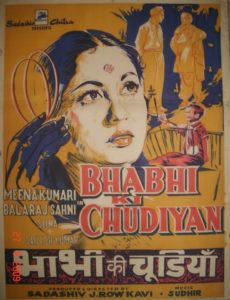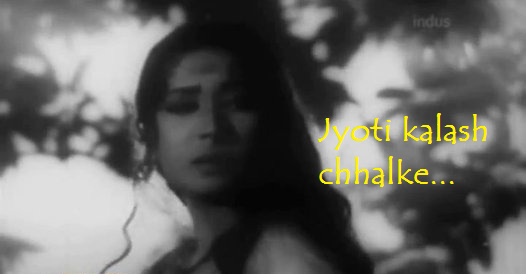Raaga Based Song of the Day: Jyoti kalash chhalke…
Raag Bhupali, Tal Kaherava
We have completed twenty days of Raaga Based Songs of the Day. Our first post in the series was titled ‘Raaga Based Song Of The Day #1’ and the song was a Mohammad Rafi and Lata Mangeshkar song from the 1970 Shakti Samanta movie Pagla Kahin Ka: Tum mujhe youn bhula na paoge. It is in Raag Jhinjhoti, Tal Kaherava.
Our twentieth post or the last post was titled ‘Raaga Based Song Of The Day #20’ and the song was a Shamshad Begum, Mohammad Rafi, Manna Dey and Asha Bhosle song from the 1957 Mehboob Khan movie Mother India: Dukh bhare din beete re bhaiya. It is in Raag Megh Malhar, Tal Dadra.
This blog has a number of posts on Raaga based songs in Hindi movies titled similarly; for example: ‘The Best Raaga Based Songs in Hindi Movies – Raaga Jaijaivanti’.
For the value added learning of today, lets delve a little more in how thew raagas are classified:
- We have already studied the most recent method of classifying raagas wherein I told you that Pandit Vishnu Narayan Bhatkhande did an extensive study of raagas and concluded that most raagas belong to the ten Thaats: Asavari, Bhairav, Bhairavi, Bilawal, Kafi, Kalyan, Khamaj or Khammaj, Marwa, Poorvi and Todi.
- Then there is classification by notes (swar) in a scale (aroha and avaroha, ie, ascending or descending scales). This is called the caste of the raga, or the jati.
- A raga with five notes is called audava,
- A raga with six notes is called a sadava,
- A raga with all seven notes is called a sampurna raga.
- Then there are combinations. If, for example, a raga has five notes in arohana and seven notes in avarohana, the jati is audava-sampurna. The total combinations, therefore, are:
- Audava – Audava
- Audava – Sadava
- Audava – Sampurna
- Sadava – Audava
- Sadava – Sadava
- Sadava – Sampurna
- Sampurna – Audava
- Sampurna – Sadava
- Sampurna – Sampurna
- The most ancient way of grouping classifying raagas is what I told you in the beginning: the raga-ragini system. The raga is the male form while the ragini is the female form. Together, they bond and form children ragas, known as raga-putras. There are thirty-six of them in total.
- Then there is classification of raagas by time of the day. A day, in the ancient system is divided into eight prahars (pahars, as given in Sri Guru Granth Sahib). There are variations in various systems. However, following is widely accepted:
- From 3 AM to 6 AM – First Prahar.
- From 6 AM to 9 AM – Second Prahar.
- From 9 AM to 12 PM – Third Prahar.
- From 12 PM to 3 PM – Fourth Prahar.
- From 3 PM to 6 PM – Fifth Prahar.
- From 6 PM to 9 PM – Sixth Prahar.
- From 9 PM to 12 AM – Seventh Prahar.
- From 12 AM to 3 AM – Eighth Prahar.

The song that I have selected for you is from the 1961 Sadashiv J Row Kavi movie Bhabhi Ki Chudiyan that starred Meena Kumari as Geeta and Balraj Sahni as Shyam, a married couple unable to have children. They treat Mohan (Sailesh Kumar), an orphan, as their son. However, when he grows up and gets married his wife is jealous of the loyalty he has towards the family. Mohan’s wife moves out of the house to her mother’s and that provides for intense drama.
This song is a creation of the lyricist Pt Narendra Sharma and a composition of Sudhir Phadke. This is as close to Raag Bhupali as you can get.
Raag Bhopali or Bhupali is a pentatonic raaga (that is five notes each in ascending (Aroha) and descending (Avaroha) scales; ie, स रे ग प ध (sa, re, ga, pa and dha). The two notes or swar that the raaga does not use are Ma (Madhyam) and Ni (Nishadh). The other day I told you why Bhairavi is the Raag that is taught to beginners and then I told you about Yaman or Kalyan. Bhupali too is a basic raaga that is taught to the beginners. Indeed, Bhupali belongs to the Kalyan Thaat. And, of course, it is not difficult to guess that the raaga is sung in the first part of the night.
Most of the compositions in Raag Bhupali are in Bhakti (devotion) rasa. Some of the Hindi films songs composed in Bhupali or Bhopali are: Dil hoom hoom kare, Pankh hote to udh aati re, Zindagi denewale sun, In aankhon ki masti ke, Neele gagan ke tale, Aap bulayen aur hum na aayen, Dekha ek khwab to ye silsile huye, Sansaar ki har shay ka, and Chanda hai tu mera suraj hai tu. It will do well to keep in mind that Hindi songs composers first priority is popular tunes and they won’t be stickler to purity of raagas in their compositions. Hence, all these songs would align with the raaga not completely.
Please enjoy Lata Mangeshkar sing: Jyoti kalash chhalake….
Jyoti kalash chhalake – 4
hue gulaabii, laal sunahare
ra.ng dal baadal ke
jyoti kalash chhalake
Ghara aa.ngana vana upavana upavana
karatii jyoti amR^ita ke sii.nchana
ma.ngala ghaTa Dhala ke – 2
jyoti kalash chhalake
Paata paata biravA hariyaalaa
dharatii kaa mukha huA ujaalaa
sacha sapane kal ke – 2
jyoti kalash chhalake
Ushhaa ne aa.Nchala phailaayaa
phailii sukha kii shiitala chhaayaa
niiche aa.Nchala ke – 2
jyoti kalash chhalake
Jyoti yashodaa dharatI maiyyaa
niila gagana gopAla kanhaiyyaa
shyaamala chhavi jhalake – 2
jyoti kalash chhalake
Ambar kumakum kaN barasaaye
phuul pa.Nkhu.Diyo.n par muskaaye
bindu tuhin jal ke – 2
jyoti kalash chhalake
We have intended to learn about Raaga based music whilst we entertain ourselves with Raaga based songs. So, lets, once again, take stock of our collective learning so far:
- On the first day we learnt about the Raaga system devised by Pandit Vishnu Narayan Bhatkhande, which is the prevalent system in Hindustani Classical Music and based on ten Thaats.
- On the second day we learnt about Tal or Taal.
- On the third day we learnt about characteristics of Raagas that included Swar, Jati, Thaat, Arohana and Avarohana, Vadi, Samvadi and Pakad.
- On the fourth day, we learnt about Sargam.
- On the fifth day, we learnt about notations used in Indian classical music or simply Swar Lipi.
- On the sixth day, we learnt about the Ras (sentiments) that Raagas evoke.
- On the seventh day, we learnt about various types of Swar: Shuddha, Achal, Vikrut, Komal and Teevra.
- On the eighth day, we learnt the parts of a composition in Indian Classical Music.
- On the ninth day, we learnt the names of some of the popular instruments used in Indian Classical Music.
- On the tenth day, we learnt about the sources of names of Raagas.
- On the eleventh day, we learnt about why Bhairavi is the first raag to be taught to beginners and also why it is the last in a performance.
- On the twelfth day, we learnt about Khammaj Thaat.
- On the thirteenth day, we learnt about Tal Punjabi Theka or Sitarkhani.
- On the fourteenth day, we learnt about Alap.
- On the fifteenth day, we learnt about List of Raagas (Raagmala) in my favourite book: Sri Guru Granth Sahib.
- On the sixteenth day, we learnt about tips for raaga identification.
- On the seventeenth day, we learnt the basics of Gharana system.
- On the eighteenth day, we learnt about Filmi Sangeet.
- On the nineteenth day, we learnt about the commonest Tal in Raagas: Tintal.
- On the twentieth day, we learnt about the Kafi Thaat.
- And today, on the twenty-first day, we learnt a little more in detail about the classification of Raagas.
There is much more still to be learnt and enjoyed.
Please stay tuned!

Outstanding
Thank you